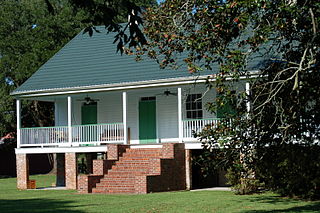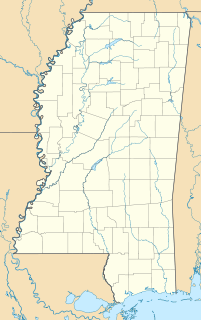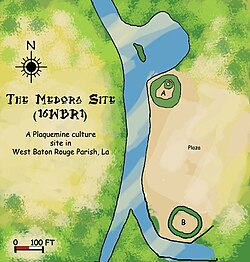
West Baton Rouge Parish is one of the sixty-four parishes in the U.S. state of Louisiana. As of the 2010 census, the population was 23,788. The parish seat is Port Allen. The parish was created in 1807.

The various cultures collectively termed "Mound Builders" were prehistoric, indigenous inhabitants of North America who, during a 5,000-year period, constructed various styles of earthen mounds for religious, ceremonial, burial, and elite residential purposes. These included the pre-Columbian cultures of the Archaic period, Woodland period, and Mississippian period; dating from roughly 3500 BCE to the 16th century CE, and living in regions of the Great Lakes, the Ohio River Valley, and the Mississippi River valley and its tributary waters.

Chunkey is a game of Native American origin. It was played by rolling disc-shaped stones across the ground and throwing spears at them in an attempt to land the spear as close to the stopped stone as possible. It originated around 600 CE in the Cahokia region of what is now the United States. Chunkey was played in huge arenas as large as 47 acres that housed great audiences designed to bring people of the region together. It continued to be played after the fall of the Mississippian culture around 1500 CE. Variations were played throughout North America. Early ethnographer James Adair translated the name to mean "running hard labor". Gambling was frequently connected with the game, with some players wagering everything they owned on the outcome of the game. Losers were even known to commit suicide.
The Taensa were a Native American people whose settlements at the time of European contact in the late 17th century were located in present-day Tensas Parish, Louisiana. The meaning of the name, which has the further spelling variants of Taenso, Tinsas, Tenza or Tinza, Tahensa or Takensa, and Tenisaw, is unknown. It is believed to be an autonym. The Taensa should not be confused with the Avoyel, known by the French as the petits Taensas, who were mentioned in writings by explorer Pierre Le Moyne d'Iberville in 1699. The Taensa are more closely related to the Natchez people and both are considered descendants of the late prehistoric Plaquemine culture.
James Alfred Ford was an American archaeologist. He was born in Water Valley, Mississippi, in February 1911. He became interested in work on Native American mound research while growing up in Mississippi.

The Kincaid Mounds Historic Site c. 1050–1400 CE, is a Mississippian culture archaeological site located at the southern tip of present-day U.S. state of Illinois, along the Ohio River. Kincaid Mounds has been notable for both its significant role in native North American prehistory and for the central role the site has played in the development of modern archaeological techniques. The site had at least 11 substructure platform mounds, and 8 other monuments.

The Anna Site is a prehistoric Plaquemine culture archaeological site located in Adams County, Mississippi 10 miles (16 km) north of Natchez. It is the type site for the Anna Phase of the Natchez Bluffs Plaquemine culture chronology. It was declared a National Historic Landmark on September 14, 1993.

Coles Creek culture is a Late Woodland archaeological culture in the Lower Mississippi valley in the Southeastern Woodlands. It followed the Troyville culture. The period marks a significant change in the cultural history of the area. Population increased dramatically and there is strong evidence of a growing cultural and political complexity, especially by the end of the Coles Creek sequence. Although many of the classic traits of chiefdom societies are not yet manifested, by 1000 CE the formation of simple elite polities had begun. Coles Creek sites are found in Arkansas, Louisiana, and Mississippi. It is considered ancestral to the Plaquemine culture.

The Plaquemine culture was an archaeological culture centered on the Lower Mississippi River valley. It had a deep history in the area stretching back through the earlier Coles Creek and Troyville cultures to the Marksville culture. The Natchez and related Taensa peoples were their historic period descendants. The type site for the culture is the Medora Site in Louisiana; while other examples include the Anna, Emerald, Holly Bluff, and Winterville sites in Mississippi.

The Aden Site is an archaeological site that is the type site for the Aden Phase of Lower Yazoo Basin Coles Creek culture chronology. It corresponds to Middle Coles Creek, chronologically between the Bayland Phase and Kings Crossing Phase.

The Tchefuncte Site (16ST1) is an archaeological site that is a type site for the prehistoric Tchefuncte culture period. The name is pronounced Che-funk'tuh. It is located in the southeast section of Fontainebleau State Park near Mandeville, St. Tammany Parish, Louisiana.

The Marksville culture was an archaeological culture in the lower Lower Mississippi valley, Yazoo valley, and Tensas valley areas of present-day Louisiana, Mississippi, Arkansas, and extended eastward along the Gulf Coast to the Mobile Bay area, from 100 BCE to 400 CE. This culture takes its name from the Marksville Prehistoric Indian Site in Avoyelles Parish, Louisiana. Marksville Culture was contemporaneous with the Hopewell cultures within present-day Ohio and Illinois. It evolved from the earlier Tchefuncte culture and into the Baytown and Troyville cultures, and later the Coles Creek and Plum Bayou cultures. It is considered ancestral to the historic Natchez and Taensa peoples.

Ghost Site Mounds is an archaeological site in Tensas Parish, Louisiana with an Early to Middle Coles Creek culture component and a Late Coles Creek to Plaquemine culture component.

Venable Mound is an archaeological site in Morehouse Parish, Louisiana with a single mound with components from the Troyville, Coles Creek and Plaquemine period.

Transylvania Mounds is an archaeological site in East Carroll Parish, Louisiana with components from the Coles Creek (700–1200)CE and Plaquemine/Mississippi periods (1200–1541). It is the type site for the Transylvania Phase of the Tensas Basin Plaquemine Mississippian chronology.

Pocahontas Mounds is an archaeological site from the Plaquemine Mississippian culture in Hinds County, Mississippi, dating from 800 to 1300 CE. Two mounds from the site were added to the NRHP on two separate occasions, Pocahontas Mound A on November 25, 1969 as NRIS number 69000365 and Pocahontas Mound B on April 11, 1972 as NRIS number 72000694.

Bayou Grande Cheniere Mounds is an archaeological site in Plaquemines Parish near the southeast corner of Louisiana. Built by the Coastal Coles Creek culture, it was inhabited from 875 to 1200 CE, from the Early Coles Creek period to the Coles Creek/Plaquemine period.

The Sims Site (16SC2), also known as Sims Place, is an archaeological site located in Saint Charles Parish, Louisiana, near the town of Paradis. The location is a multi-component mound and village complex with platform mounds and extensive midden deposits. The site habitations are divided into three periods. It was first inhabited about 800 CE by peoples of the Coastal Coles Creek culture. By 1100 CE the culture of the site had transitioned into the Mississippianized Plaquemine culture that lasted until 1450 CE. A little later was a Late Mississippian/protohistoric period that lasted from 1500 until about 1700 or 1800.

Morgan Mounds is an important archaeological site of the Coastal Coles Creek culture, built and occupied by Native Americans from 700 to 1000 CE on Pecan Island in Vermilion Parish, Louisiana. Of the 45 recorded Coastal Coles Creek sites in the Petite Anse region, it is the only one with ceremonial substructure mounds. These indicate that it was possibly the center of a local chiefdom.

The Atchafalaya Basin Mounds is an archaeological site originally occupied by peoples of the Coastal Coles Creek and Plaquemine cultures beginning around 980 CE, and by their presumed historic period descendants, the Chitimacha, during the 18th century. It is located in St. Mary Parish, Louisiana on the northern bank of Bayou Teche at its confluence with the Lower Atchafalaya River. It consists of several earthen platform mounds and a shell midden situated around a central plaza. The site was visited by Clarence Bloomfield Moore in 1913.















